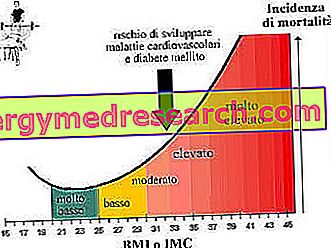In this latest article dedicated to the calculation of the ideal weight, we will refer to various formulas. Before proposing it to you, we will illustrate the main factors that can influence it, in order to provide all the tools for a quick, correct and personalized calculation. The ideal weight corresponds to the body weight reached at the end of a harmonious development
Category anthropometry
Edited by: Luca Giovanni Bottoni Gone are the times in which we trusted the home balance, an instrument that is based on measuring the global weight of whatever we lean on, not taking into account different aspects of the human body as its composition "fundamental factor for a evaluation of a physical state "
One of the most precise and fast methods for assessing body composition Bio-impedancemetry is a fast and precise method for assessing the body composition (CC) of human beings (1985 Lukaski). Body composition The analysis of body composition is used in various sectors, such as: medicine, anthropology, ergonomics, sports, auxology
By Dr. Simone Losi The first step in order to organize a truly personalized training card, and appropriate nutrition, is the objective knowledge of body composition. The plicometry, which is based on the use of a plicometer through which the subject's percentage of fat mass is extrapolated, presents a very significant limit: it assumes that the subject is well hydrated, ie that he has a percentage of total body water of the 60%
The following equations allow to calculate the INDICATIVE percentage of body fat starting from the BMI value. IL BMI is obtained by dividing one's weight in kg with the square of the height expressed in meters. Example : If your weight is 80 kg and you are 185 cm tall, your BMI. is: 80 / (1.85 x 1
The Body Mass Index (BMI) - Italianized with the initials IMC (Body Mass Index) - is obtained by dividing the body weight (expressed in kg) by the height (in meters) squared. With a simple calculation, a value is thus obtained, expressed in kg / m2, which correlates very well with the fat mass of the subject; in general, the higher this number corresponds to BMI, the greater the lipid deposits
The BMI is the index most used to obtain a general assessment of one's body weight The Body Mass Index (BMI) or Body Mass Index (BMI) is a parameter widely used to obtain a general assessment of one's body weight. It relates the height to the weight of the subject with a simple mathematical formula
Converting a certain value from one unit of measurement to another means multiplying it by the appropriate conversion factor. The quantity obviously remains the same, what changes is simply the way of expressing it. If an item costs 10 euros, we can for example buy it with 10 coins of 1 euro or with 1000 coins of a cent
The circumference of the arm is a widely used anthropometric measure, as it provides a quick estimate of the muscle mass of a subject. It is therefore used in sports, to monitor the athlete's degree of hypertrophy, but also in the health sector, to assess the loss or purchase of lean mass (malnutrition, rehabilitation after trauma or surgery, convalescence, etc
The circumference of the neck is an anthropometric datum used above all to evaluate the distribution of adipose tissue in the upper part of the body. In relation to its value a person is considered: OVERWEIGHT if the circumference of the package is: between 37 and 39.4 cm (man) between 34 and 36.4 cm (woman) OBESA if this value is: ≥ 39.5
Thigh circumference : the widest point is below the gluteal fold. Similar to the circumference of the arm, it is used to assess the state of nutrition and the muscle mass of the subject. When compared with the abdominal circumference, it can give an idea of the distribution of body fat (not valid for bodybuilders): WHT (Waist / Tigh Ratio) = waist circumference / thigh circumference Android obesity if WHT> 1.50







